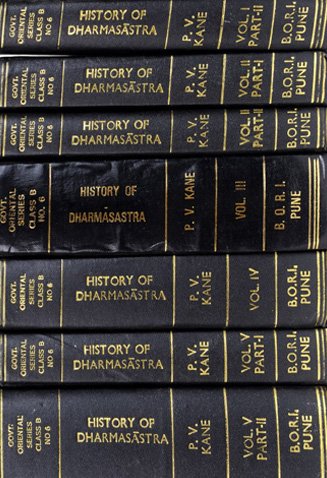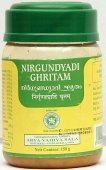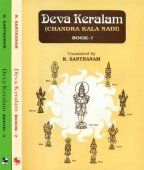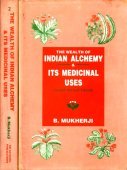Agada, Āgada: 21 definitions
Introduction:
Agada means something in Buddhism, Pali, Hinduism, Sanskrit, Jainism, Prakrit, Marathi, biology. If you want to know the exact meaning, history, etymology or English translation of this term then check out the descriptions on this page. Add your comment or reference to a book if you want to contribute to this summary article.
Images (photo gallery)
In Hinduism
Dharmashastra (religious law)
Source: Wisdom Library: Dharma-śāstraAgada (अगद) is a Sanskrit technical term, used in jurisdiction, referring to “that in good health” (freedom from disease and state or divine oppression). The word is used throughout Dharmaśāstra literature such as the Manusmṛti. (See the Manubhāṣya 8.107)

Dharmashastra (धर्मशास्त्र, dharmaśāstra) contains the instructions (shastra) regarding religious conduct of livelihood (dharma), ceremonies, jurisprudence (study of law) and more. It is categorized as smriti, an important and authoritative selection of books dealing with the Hindu lifestyle.
Ayurveda (science of life)
Source: gurumukhi.ru: Ayurveda glossary of termsAgada (अगद):—Antitoxic medication.

Āyurveda (आयुर्वेद, ayurveda) is a branch of Indian science dealing with medicine, herbalism, taxology, anatomy, surgery, alchemy and related topics. Traditional practice of Āyurveda in ancient India dates back to at least the first millenium BC. Literature is commonly written in Sanskrit using various poetic metres.
Sports, Arts and Entertainment (wordly enjoyments)
Source: archive.org: Syainika Sastra of Rudradeva with English Translation (art)Agada (अगद) refers to a “healthy (bird)”, according to the Śyainika-śāstra: a Sanskrit treatise dealing with the divisions and benefits of Hunting and Hawking, written by Rājā Rudradeva (or Candradeva) in possibly the 13th century.—Accordingly, [while discussing the treatment of hawks]: “Finding the birds healthy (agada) and well-developed by the use of the tonic medicines mentioned above, and when they look beautiful with their fresh-grown feathers and handsome with their wings which shine like sapphire, when they look charming with feathers on their breast looking like pearls, [...] their owner should then call them on auspicious day. [...]”.

This section covers the skills and profiencies of the Kalas (“performing arts”) and Shastras (“sciences”) involving ancient Indian traditions of sports, games, arts, entertainment, love-making and other means of wordly enjoyments. Traditionally these topics were dealt with in Sanskrit treatises explaing the philosophy and the justification of enjoying the pleasures of the senses.
In Buddhism
Theravada (major branch of Buddhism)
Source: Pali Kanon: Pali Proper NamesCakkavatti, sixteen times in succession; Subahu Thera in a previous birth. ThagA.i.124.
Theravāda is a major branch of Buddhism having the the Pali canon (tipitaka) as their canonical literature, which includes the vinaya-pitaka (monastic rules), the sutta-pitaka (Buddhist sermons) and the abhidhamma-pitaka (philosophy and psychology).
In Jainism
General definition (in Jainism)
Source: academia.edu: Rare Sanskrit Words from the Commentary on the Bṛhat-kalpa-bhāṣyaAgaḍa (अगड) refers to a “hole”, “well” or “ditch”.— In his publication for the Journal of Jaina Studies, Yutaka Kawasaki collected in a non-definite list several rare Sanskrit words from Malayagiri’s and Kṣemakīrti’s commentaries on the Bṛhatkalpabhāṣya: a 6th century commentary on monastic discipline authored by Svetambara Jain exegete Saṅghadāsa. Agaḍa is mentioned in Kṣemakīrti’s commentary on gāthā 676 (v. 1 p. 202 l. 6).

Jainism is an Indian religion of Dharma whose doctrine revolves around harmlessness (ahimsa) towards every living being. The two major branches (Digambara and Svetambara) of Jainism stimulate self-control (or, shramana, ‘self-reliance’) and spiritual development through a path of peace for the soul to progess to the ultimate goal.
Biology (plants and animals)
Source: Google Books: CRC World Dictionary (Regional names)Agada in India is the name of a plant defined with Saussurea costus in various botanical sources. This page contains potential references in Ayurveda, modern medicine, and other folk traditions or local practices It has the synonym Aucklandia lappa Decne. (among others).
Example references for further research on medicinal uses or toxicity (see latin names for full list):
· Linnaea (1846)
· Transactions of the Linnean Society of (1845)
· Iconographia Cormophytorum Sinicorum (6700)
· Dict. Sci. Nat. (1827)
· Fl. Yunnan. (2003)
· Revisio Generum Plantarum (1891)
If you are looking for specific details regarding Agada, for example extract dosage, side effects, diet and recipes, pregnancy safety, health benefits, chemical composition, have a look at these references.

This sections includes definitions from the five kingdoms of living things: Animals, Plants, Fungi, Protists and Monera. It will include both the official binomial nomenclature (scientific names usually in Latin) as well as regional spellings and variants.
Languages of India and abroad
Pali-English dictionary
Source: BuddhaSasana: Concise Pali-English Dictionaryagada : (nt.) medicine, drug.
Source: Sutta: The Pali Text Society's Pali-English DictionaryAgada, (Vedic agada; a + gada) medicine, drug, counterpoison J.I, 80 (°harīṭaka); Miln.121, 302, 319, 334; DA.I, 67; DhA.I, 215; PvA.198 (= osadhaṃ). (Page 3)
— or —
Āgada, (m.) & Āgadana (nt.) (ā + gad to speak) a word; talk, speech DA.I, 66 (= vacana). (Page 95)

Pali is the language of the Tipiṭaka, which is the sacred canon of Theravāda Buddhism and contains much of the Buddha’s speech. Closeley related to Sanskrit, both languages are used interchangeably between religions.
Marathi-English dictionary
Source: DDSA: The Molesworth Marathi and English Dictionaryagaḍā (अगडा).—m The tie connecting the jūṃ & dāṇḍī of a gāḍā or load-cart; the shaft and thill-yoke-tie.
--- OR ---
āgaḍā (आगडा).—m (Commonly aghāḍā) A plant, Achyranthes aspera.
Source: DDSA: The Aryabhusan school dictionary, Marathi-Englishagada (अगद).—n Medicine.
Marathi is an Indo-European language having over 70 million native speakers people in (predominantly) Maharashtra India. Marathi, like many other Indo-Aryan languages, evolved from early forms of Prakrit, which itself is a subset of Sanskrit, one of the most ancient languages of the world.
Sanskrit dictionary
Source: DDSA: The practical Sanskrit-English dictionaryAgada (अगद).—a. [nāsti gado rogo yasya]
1) Healthy, sound, free from disease, in good health नरोऽगदः (naro'gadaḥ) Manusmṛti 8.17.
2) (gad bhāṣaṇe-ac, na. ta.) Not speaking or telling.
3) Free from judicial affliction.
-daḥ [nāsti gado rogo yasmāt]
1) A medicine, a medicinal drug; इति चिन्ताविषघ्नोऽयमगदः किं न पीयते (iti cintāviṣaghno'yamagadaḥ kiṃ na pīyate) H.Pr.29; विषघ्नैरगदैश्चास्य सर्वद्रव्याणि योजयेत् (viṣaghnairagadaiścāsya sarvadravyāṇi yojayet) Manusmṛti 7. 218.
2) Health, freedom from disease; औषधान्यगदो विद्या देवी च विविधा स्थितिः । तपसैव प्रसिध्यन्ति तपस्तेषां हि साधनम् (auṣadhānyagado vidyā devī ca vividhā sthitiḥ | tapasaiva prasidhyanti tapasteṣāṃ hi sādhanam) || Ms. 11.237. (agadaḥ gadābhāvaḥ nairujyamiti yāvat Kull.)
3) The science of antidotes; one of the 8 parts of medical science.
-rājaḥ good medicine; श्रेयस्तनोत्यगदराज इवोपयुक्तः (śreyastanotyagadarāja ivopayuktaḥ) Bhāgavata 1.47.59.
Source: Cologne Digital Sanskrit Dictionaries: Shabda-Sagara Sanskrit-English DictionaryAgada (अगद).—m.
(-daḥ) A medicament, a medicine, a drug. mfn.
(-daḥ-dā-daṃ) 1. Well, healthy, free from disease. 2. Wholesome, salubrious. E. a neg. and gada disease.
Source: Cologne Digital Sanskrit Dictionaries: Cappeller Sanskrit-English DictionaryAgada (अगद).—1. [masculine] not-disease, health.
--- OR ---
Agada (अगद).—2. [adjective] free from disease, well, healthy; [masculine] medicine, drug.
Source: Cologne Digital Sanskrit Dictionaries: Monier-Williams Sanskrit-English Dictionary1) Agada (अगद):—[=a-gada] mfn. free from disease healthy, [Ṛg-veda] etc.
2) [v.s. ...] free from affliction, [Manu-smṛti]
3) [from a-gada] a magic jewel, [Divyāvadāna]
4) [v.s. ...] m. freedom from disease, [Manu-smṛti]
5) [v.s. ...] a medicine, drug, (especially) antidote, [Manu-smṛti]
Source: Cologne Digital Sanskrit Dictionaries: Goldstücker Sanskrit-English DictionaryAgada (अगद):—[bahuvrihi compound] I. m. f. n.
(-daḥ-dā-dam) 1) Free from disease, healthy.
2) Wholesome, salubrious.
3) (In law.) Unafflicted, one free from any calamity inflicted by God or the king. Ii. m.
(-daḥ) 1) A medicament, a drug.
2) Alexipharmacy, one of the eight branches of medicine. E. a priv. and gada.
Source: Cologne Digital Sanskrit Dictionaries: Yates Sanskrit-English DictionaryAgada (अगद):—[a-gada] (daḥ) 1. m. A medicine; a. Healthy, wholesome.
Source: DDSA: Paia-sadda-mahannavo; a comprehensive Prakrit Hindi dictionary (S)Agada (अगद) in the Sanskrit language is related to the Prakrit word: Agaya.
[Sanskrit to German]
Sanskrit, also spelled संस्कृतम् (saṃskṛtam), is an ancient language of India commonly seen as the grandmother of the Indo-European language family (even English!). Closely allied with Prakrit and Pali, Sanskrit is more exhaustive in both grammar and terms and has the most extensive collection of literature in the world, greatly surpassing its sister-languages Greek and Latin.
Prakrit-English dictionary
Source: DDSA: Paia-sadda-mahannavo; a comprehensive Prakrit Hindi dictionary1) Agaḍa (अगड) in the Prakrit language is related to the Sanskrit word: Avaṭa.
2) Agaḍa (अगड) also relates to the Sanskrit word: Avaṭa.
3) Agaḍa (अगड) also relates to the Sanskrit word: Akṛta.
Prakrit is an ancient language closely associated with both Pali and Sanskrit. Jain literature is often composed in this language or sub-dialects, such as the Agamas and their commentaries which are written in Ardhamagadhi and Maharashtri Prakrit. The earliest extant texts can be dated to as early as the 4th century BCE although core portions might be older.
Kannada-English dictionary
Source: Alar: Kannada-English corpusAgaḍa (ಅಗಡ):—
1) [noun] a wilfully troublesome man; a mischievous man.
2) [noun] the quality of being troublesome, wicked or harmful; mischievousness; wickedness.
3) [noun] (dial.) a chord or rope tied round the neck of a draft animal, such as an ox.
--- OR ---
Agada (ಅಗದ):—[adjective] free from disease; sound; healthy.
--- OR ---
Agada (ಅಗದ):—
1) [noun] freedom from disease; good health.
2) [noun] any substance used (internally or applied externally like a balm, ointment,) for the treatment or prevention of a disease or curing a wound etc; a medicine.
3) [noun] the science of antidotes.
--- OR ---
Āgaḍa (ಆಗಡ):—[noun] an improper or wicked act; a crime; a sin.
--- OR ---
Āgaḍa (ಆಗಡ):—[adverb] = ಆಗ [aga]1.
--- OR ---
Āgāḍa (ಆಗಾಡ):—[noun] any line or thing marking a limit of a place, state, country etc. ; border.
Kannada is a Dravidian language (as opposed to the Indo-European language family) mainly spoken in the southwestern region of India.
See also (Relevant definitions)
Starts with (+7): Agadabagada, Agadabamba, Agadadatta, Agadadhagada, Agadadhu, Agadadhuta, Agadadigada, Agadagu, Agadakara, Agadama-bagadama, Agadamabagadama, Agadamkara, Agadankara, Agadaravuta, Agadatagada, Agadatana, Agadatantra, Agadaveda, Agadavigada, Akata-patuncamayam.
Ends with (+131): Abhinavagada, Abhinivvagada, Agadabagada, Agadadhagada, Agadatagada, Agagada, Aginagada, Alagada, Amcekagada, Amtaralagada, Anagada, Arabitagada, Avagada, Avijnatagada, Avvagada, Bagada, Bahadurakhani Kagada, Bailagada, Bairagada, Balukagada.
Full-text (+16): Agadamkara, Gadagada, Agadankara, Agadaveda, Agady, Agadatana, Avata, Akrita, Akatan, Akatakaran, Aledandi, Ksharagada, Agaya, Agadya, Akatiyam, Agadutana, Agadu, Viryatama, Mahagada, Vishaghna.
Relevant text
Search found 23 books and stories containing Agada, Āgaḍa, Agaḍa, A-gada, Āgaḍā, Agaḍā, Āgada, Āgāḍa; (plurals include: Agadas, Āgaḍas, Agaḍas, gadas, Āgaḍās, Agaḍās, Āgadas, Āgāḍas). You can also click to the full overview containing English textual excerpts. Below are direct links for the most relevant articles:
Rig Veda (translation and commentary) (by H. H. Wilson)
Sushruta Samhita, Volume 5: Kalpasthana (by Kaviraj Kunja Lal Bhishagratna)
Chapter V - The medical treatment of snake bites
Chapter VIII - The medical treatment of insect bites
Manusmriti with the Commentary of Medhatithi (by Ganganatha Jha)
Verse 8.107 < [Section XVI - Abstaining from giving evidence]
Maha Prajnaparamita Sastra (by Gelongma Karma Migme Chödrön)
I. Recollection of the Buddha (1): The ten names (adhivacana) < [Part 2 - The Eight Recollections according to the Abhidharma]
Act 9.2: Examination of the plurality of Buddha < [Chapter XV - The Arrival of the Bodhisattvas of the Ten Directions]
Hiranyakesi-grihya-sutra (by Hermann Oldenberg)
Chaitanya Bhagavata (by Bhumipati Dāsa)
Verse 2.19.64 < [Chapter 19 - The Lord’s Pastimes in Advaita’s House]
Related products






